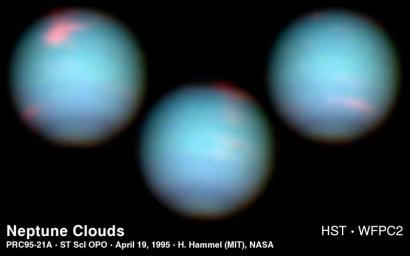These NASA Hubble Space Telescope views of the blue-green planet Neptune provide three snapshots of changing weather conditions. The images were taken in 1994 on October 10 (upper left), October 18 (upper right), and November 2 (lower center), when Neptune was 2.8 billion miles (4.5 billion kilometers) from Earth.
Hubble is allowing astronomers to study Neptune's dynamic atmosphere with a level of detail not possible since the 1989 flyby of the Voyager 2 space probe. Building on Voyager's initial discoveries, Hubble is revealing that Neptune has a remarkably dynamic atmosphere that changes over just a few days.
The temperature difference between Neptune's strong internal heat source and its frigid cloud tops (-260 degrees Fahrenheit) might trigger instabilities in the atmosphere that drive these large-scale weather changes. In addition to hydrogen and helium, the main constituents, Neptune's atmosphere is composed of methane and hydrocarbons, like ethane and acetylene.
The picture was reconstructed from a series of Wide Field Planetary Camera 2 images taken through different colored filters at visible and near-infrared wavelengths. Absorption of red light by methane in Neptune's atmosphere contributes to the planet's distinctive aqua color; the clouds themselves are also somewhat blue. The pink features are high-altitude methane ice crystal clouds. Though the clouds appear white in visible light, they are tinted pink here because they were imaged at near infrared wavelengths.
The farthest of the gas giant planets, Neptune is four times Earth's diameter. Though Neptune was discovered in 1846, very little has been known about it until the advent of space travel and advanced telescopes.
The Wide Field/Planetary Camera 2 was developed by the Jet Propulsion Laboratory and managed by the Goddard Space Flight Center for NASA's Office of Space Science.
This image and other images and data received from the Hubble Space Telescope are posted on the World Wide Web on the Space Telescope Science Institute home page at URL http://oposite.stsci.edu/.

 Planetary Data System
Planetary Data System












